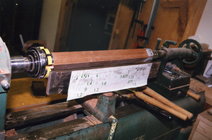This spring I tackled designing and turning 108 balusters for our new deck. This is no big deal to you professional turners, but for an amateur like me it was a big challenge, and it turned out to be a lot of fun too. Here's a short video I made late in the process. The deck is still being built, so I don't yet have any installation photos.
During the work I got two very helpful technical tips. First, from Mike Darlow: to beat vibration, instead of a steady rest, just grab the head end of the workpiece in a scroll chuck, rather than on a spur center - it worked! And from the guys in our club, rig up a full-length tool rest rather than moving the banjo several times - that worked too! The first one took 25 minutes to turn, by the end they were coming off the lathe every 10 minutes, and my skills had ticked up a lot. Take a look, see what you think -
View: https://youtu.be/vTwmeZ0JlgA
During the work I got two very helpful technical tips. First, from Mike Darlow: to beat vibration, instead of a steady rest, just grab the head end of the workpiece in a scroll chuck, rather than on a spur center - it worked! And from the guys in our club, rig up a full-length tool rest rather than moving the banjo several times - that worked too! The first one took 25 minutes to turn, by the end they were coming off the lathe every 10 minutes, and my skills had ticked up a lot. Take a look, see what you think -
Last edited:

